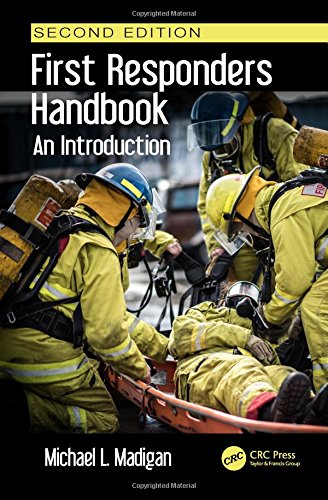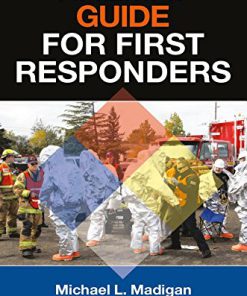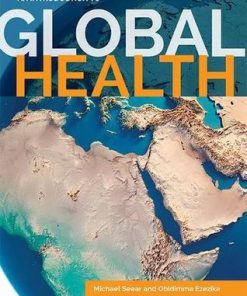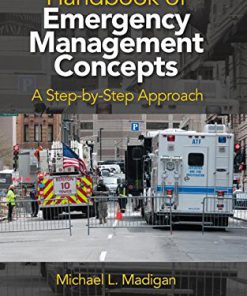First Responders Handbook An Introduction 1st edition by Michael Madigan ISBN 1351612077 9781351612074
$50.00 Original price was: $50.00.$25.00Current price is: $25.00.
First Responders Handbook An Introduction Second Edition 1st edition by Michael L. Madigan – Ebook PDF Instant Download/Delivery: 1351612077, 978-1351612074
Full download First Responders Handbook An Introduction 1st Edition after payment

Product details:
ISBN 10: 1351612077
ISBN 13: 978- 1351612074
Author: Michael L. Madigan
The objective of this handbook is to make available in a quick reference form, the information to enhance and support the response capabilities of firefighters, emergency medical technicians, hazardous materials response teams, law enforcement officers, bomb squads, medical doctors and nurses, emergency managers, schools, and others. This handbook is dedicated and committed to disaster prevention, preparedness, readiness, response, mitigation and recovery efforts. This is an ideal book for newcomers to the field, and can be used for fast knowledge for application to any areas of response.
First Responders Handbook An Introduction 1st Table of contents:
Chapter 1: NIMS and the Incident Command System
- Introduction: Overview of the Incident Command System (ICS) and its application in managing emergencies.
- History: Development of ICS as a response to large-scale disasters.
- National Incident Management System (NIMS): NIMS framework for coordinating responses across jurisdictions.
- ICS Management: The role of ICS in organizing resources and personnel during an incident.
- Training: Available courses and certifications for ICS training.
- Conclusion: Importance of NIMS and ICS in efficient disaster management.
Chapter 2: Security Management
- Introduction: General overview of security management.
- Types of Security Threats: Differentiates between external and internal threats.
- Risk Management: Methods of risk avoidance, reduction, transfer, and acceptance.
- Security Policy: Implementation of security measures like intrusion detection, access control, and physical security.
- Alarm Management: Detailed steps in improving alarm management, including nuisance reduction and real-time monitoring.
- IT Risk Management: Methods to measure and manage IT-related security risks.
Chapter 3: Threat/Vulnerability Assessments and Risk Analysis
- Introduction: Key concepts in assessing threats, vulnerabilities, and risks.
- Assessment Tools: Tools for evaluating electronic threats and IT risks.
- Risk Characterization: Principles for evaluating potential threats and their impacts.
- Conclusion: Importance of conducting regular risk assessments to prepare for threats.
Chapter 4: Defense Support of Civil Authorities (DSCA)
- Introduction: Role of the military and defense forces in supporting civil authorities during emergencies.
- MOOTW (Military Operations Other Than War): Discusses military involvement in non-combat operations such as peacekeeping.
- Global Deployments: Examples from the US, UK, Japan, and Australia.
- Conclusion: Overview of how military support enhances civil authority capabilities.
Chapter 5: Introduction to Weapons of Mass Destruction (WMDs)
- Chemical Weapons: Risks, types of agents (nerve agents, vesicants, blood agents), and treatment guidelines.
- Biological Weapons: Focus on bioterrorism and classification of biological agents (Category A, B, C).
- Radiological and Nuclear Weapons: Differentiate between radiation and radioactive materials, protection methods, and detection.
- Explosive/Incendiary Weapons: Discusses widely used WMDs and their impact.
- Cyberwarfare: The role of cyber threats in modern terrorism.
Chapter 6: Understanding Terror, Terrorism, and Their Roots
- Terrorism Definition: Exploration of terrorism’s origins, types, and motivations.
- Modern Terrorism: The rise of non-state terrorism, religious extremism, and international terrorism.
- Terrorist Tactics: Focus on improvised explosive devices (IEDs), the role of the internet, and psychological warfare.
Chapter 7: CBRNE and Weapons of Mass Destruction
- Chemical, Biological, Radiological, Nuclear, and Explosive (CBRNE) Weapons: Detailed breakdown of these WMD categories, including tactics and the risks posed by industrial chemicals.
- Terrorism: Overview of how industrial chemicals and biological agents are weaponized.
Chapter 8: Explosives
- Types of Explosives: Chemical, decomposition, deflagration, detonation, and exotic explosives.
- Properties: Sensitivity, stability, brisance, and other key properties of explosives.
- Classification: By sensitivity, velocity, composition, and shipping classifications.
- Explosions: Effects such as force, fragmentation, and thermal evolution.
Chapter 9: Nuclear Weapons and Radiation
- Nuclear Weapons: History, fission and fusion weapons, and their delivery systems.
- Nuclear Terrorism: The threat posed by militant groups and nuclear material incidents.
- Nuclear Strategy: Strategic considerations in nuclear weapons use.
Chapter 10: Dirty Bomb
- Impact and Protective Actions: Explains what a dirty bomb (radiological dispersal device) is, its potential impacts, and safety measures.
- Radioactive Materials: How terrorists might use radioactive materials, risks, and protective guidelines.
- Risk of Cancer: Addressing public concern over cancer risks from radiation exposure.
Chapter 11: Decontamination Procedures
- Types of Contamination: Various types of contamination and their management.
- Decontamination Methods: Procedures for decontaminating personnel, equipment, and areas exposed to hazardous materials.
- Emergency Decontamination: Guidelines for immediate decontamination in emergencies.
Chapter 12: Decontamination of Chemical Warfare and Industrial Agents
- Chemical Warfare Agents: Specific decontamination methods for chemical agents.
- Mass Casualty Decontamination: Prioritizing casualties and methods for large-scale decontamination.
- Environmental Concerns: Impact of decontamination on the environment.
Chapter 13: Chemical Protective Clothing
- Protective Clothing Applications: Guidelines for selecting and using protective clothing in hazardous environments.
- Training and Maintenance: Importance of training, inspection, and proper use of protective clothing.
Chapter 14: Emergency Response Guidebook
- Guidebook Overview: Details of the guidebook’s contents, including classification and labeling of hazardous materials.
- Shipping Lists: Guidance on classifying hazardous materials by class (e.g., explosives, gases, flammable liquids, etc.).
- Hazard Communication: Introduction to the Globally Harmonized System (GHS) and the importance of clear labeling and classification of chemicals.
People also search forFirst Responders Handbook An Introduction 1st :
first responders definition and examples
what are the responsibilities of a first responder
best first responders discounts
certified first responder (cfr)
do first responders get discounts
Tags:
Michael Madigan,First,Responders,Handbook,Introduction 1st
You may also like…
Biology and other natural sciences - Biophysics
An Introduction to Single Molecule Biophysics First Edition Yuri L. Lyubchenko
Politics & Philosophy - Social Sciences
Medicine - Endocrinology
Business & Economics - Management & Leadership
Cookbooks
Mathematics - Mathematical Statistics
Psychometrics An Introduction 3rd Edition by R Michael Furr ISBN 1506339867 978-1506339863












